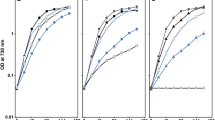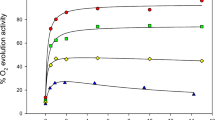Abstract
Whole cells of the purple sulfur bacterium strain 970 exhibit an unusual absorption peak at 963 nm. Its closest relatives, Thiorhodovibrio (Trv.) winogradskyi DSM6702T and strain 06511 display a bacteriochlorophyll (BChl) a absorption peak at 867 nm that is characteristic for most light-harvesting complexes 1 (LHC1) of proteobacteria. The puf operons encoding the LHC1 and reaction center proteins were amplified, cloned, and sequenced, and for the Trv. winogradskyi, strains show the common pufBALMC gene arrangement, whereas strain 970 contains a second pufBA copy downstream of pufC. Only pufB 1 A 1 is transcribed, and the corresponding mRNA fragment had an increased stability. Alignments of the deduced protein sequences showed that the LHC1 polypeptides are closely related to those of Thermochromatium (Tch.) tepidum. A deletion between αHis0 and αTrp+11, thought to be responsible for the redshifted Q y absorption in Tch. tepidum, was also detected in strain 970 and Trv. winogradskyi, whereas αLys+12 is replaced by histidine only in strain 970. Based on our structural modeling, the side chain of this αHis is predicted to be in close proximity to the BChl a, suggesting that it exerts a modulating effect on the spectral properties of the highly unusual LHC1 complex of strain 970.






Similar content being viewed by others
References
Altschul SF, Madden TL, Schäffer AA, Zhang J, Zhang Z, Miller W, Lipman DJ (1997) Gapped BLAST and PSI-BLAST: a new generation of protein database search programs. Nucleic Acids Res 25:3389–3402
Arnold K, Bordoli L, Kopp J, Schwede T (2006) The SWISS-MODEL workspace: a web-based environment for protein structure homology modelling. Bioinformatics 22:195–201
Bauer CE, Bird TH (1996) Regulatory circuits controlling photosynthesis gene expression. Cell 85:5–8
Beja O, Suzuki MT, Heidelberg JF, Nelson WC, Preston CM, Hamada T, Eisen JA, Fraser CM, DeLong EF (2002) Unsuspected diversity among marine aerobic anoxygenic phototrophs. Nature 415:630–633
Bélanger G, Gingras G (1988) Structure and expression of the puf operon messenger RNA in Rhodospirillum rubrum. J Biol Chem 263:7639–7645
Benson DA, Karsch-Mizrachi I, Lipman DJ, Ostell J, Wheeler DL (2008) GenBank. Nucleic Acids Res 36:D25–D30
Berman HM, Westbrook J, Feng Z, Gilliland G, Bhat TN, Weissig H, Shindyalov IN, Bourne PE (2000) The protein data bank. Nucleic Acids Res 28:235–242
Bullough PA, Qian P, Hunter CN (2008) Reaction center-light-harvesting core complexes of purple bacteria. In: Hunter CN et al (eds) The purple phototrophic bacteria. Springer, Netherlands, pp 155–179
Campbell EA, Korzheva N, Mustaev A, Murakami K, Nair S, Goldfarb A, Darst SA (2001) Structural mechanism for rifampicin inhibition of bacterial RNA polymerase. Cell 104:901–912
Chen CA, Beatty JT, Cohen SN, Belasco JG (1988) An intercistronic stem-loop structure functions as an mRNA decay terminator necessary but insufficient for puf mRNA stability. Cell 52:609–619
Chomczynski P, Sacchi N (1987) Single-step method of RNA isolation by acid guanidinium thiocyanate-phenol-chloroform extraction. Anal Biochem 162:156–159
Cogdell RJ, Isaacs NW, Howard TD, McLuskey K, Fraser NJ, Prince SM (1999) How photosynthetic bacteria harvest solar energy. J Bacteriol 181:3869–3879
Cogdell R, Howard T, Isaacs N, McLuskey K, Gardiner A (2002) Structural factors which control the position of the Q y absorption band of bacteriochlorophyll a in purple bacterial antenna complexes. Photosynth Res 74:135–141
Conroy MJ, Westerhuis WH, Parkes-Loach PS, Loach PA, Hunter C, Williamson MP (2000) The solution structure of Rhodobacter sphaeroides LH1[beta] reveals two helical domains separated by a more flexible region: structural consequences for the LH1 complex. J Mol Biol 298:83–94
Davis CM, Bustamante PL, Todd JB, Parkes-Loach PS, McGlynn P, Olsen JD, McMaster L, Hunter CN, Loach PA (1997) Evaluation of structure–function relationships in the core light-harvesting complex of photosynthetic bacteria by reconstitution with mutant polypeptides. Biochemistry 36:3671–3679
Eccles J, Honig B (1983) Charged amino acids as spectroscopic determinants for chlorophyll in vivo. Proc Natl Acad Sci USA 80:4959–4962
Ehretsmann CP, Carpousis AJ, Krisch HM (1992) Specificity of Escherichia coli endoribonuclease RNase E: in vivo and in vitro analysis of mutants in a bacteriophage T4 mRNA processing site. Genes Dev 6:149–159
Garcia D, Parot P, Verméglio A, Madigan M (1986) The light-harvesting complexes of a thermophilic purple sulfur photosynthetic bacterium Chromatium tepidum. Biochim Biophys Acta Bioenergetics 850:390–395
Glaeser J, Overmann J (1999) Selective enrichment and characterization of Roseospirillum parvum, gen. nov. and sp. nov., a new purple nonsulfur bacterium with unusual light absorption properties. Arch Microbiol 171:405–416
Gregor J, Klug G (1999) Regulation of bacterial photosynthesis genes by oxygen and light. FEMS Microbiol Lett 179:1–9
Gudowska-Nowak E, Newton MD, Fajer J (1990) Conformational and environmental effects on bacteriochlorophyll optical spectra: correlations of calculated spectra with structural results. J Phys Chem 94:5795–5801
Guex N, Peitsch MC (1997) SWISS-MODEL and the Swiss-PdbViewer: an environment for comparative protein modeling. Electrophoresis 18:2714–2723
Karrasch S, Bullough PA, Ghosh R (1995) The 8.5 A projection map of the light-harvesting complex I from Rhodospirillum rubrum reveals a ring composed of 16 subunits. EMBO J 14:631–638
Kimura Y, Hirano Y, Yu L, Suzuki H, Kobayashi M, Wang Z (2008) Calcium ions are involved in the unusual red shift of the light-harvesting 1 Q(y) transition of the core complex in thermophilic purple sulfur bacterium Thermochromatium tepidum. J Biol Chem 283:13867–13873
Klug G (1993) The role of mRNA degradation in the regulated expression of bacterial photosynthesis genes. Mol Microbiol 9:1–7
Klug G, Adams CW, Belasco J, Doerge B, Cohen SN (1987) Biological consequences of segmental alterations in mRNA stability: effects of deletion of the intercistronic hairpin loop region of the Rhodobacter capsulatus puf operon. EMBO J 6:3515–3520
Koepke J, Hu X, Muenke C, Schulten K, Michel H (1996) The crystal structure of the light-harvesting complex II (B800–850) from Rhodospirillum molischianum. Structure 4:581–597
Lane D (1991) 16S/23S rRNA sequencing. In: Stackebrandt E, Goodfellow M (eds) Nucleic acid techniques in bacterial systematics. Wiley, Chichester, pp 115–175
Larkin MA, Blackshields G, Brown NP, Chenna R, McGettigan PA, McWilliam H, Valentin F, Wallace IM, Wilm A, Lopez R, Thompson JD, Gibson TJ, Higgins DG (2007) Clustal W and Clustal X version 2.0. Bioinformatics 23:2947–2948
Ludwig W, Strunk O, Westram R, Richter L, Meier H, Yadhukumar BA, Lai T, Steppi S, Jobb G, Förster W, Brettske I, Gerber S, Ginhart AW, Gross O, Grumann S, Hermann S, Jost R, König A, Liss T et al (2004) ARB: a software environment for sequence data. Nucleic Acids Res 32:1363–1371
Ma F, Kimura Y, Yu L, Wang P, Ai X, Wang Z, Zhang J (2009) Specific Ca2+-binding motif in the LH1 complex from photosynthetic bacterium Thermochromatium tepidum as revealed by optical spectroscopy and structural modeling. FEBS J 276:1739–1749
Madigan MT (1984) A novel photosynthetic purple bacterium isolated from a Yellowstone hot spring. Science 225:313–315
Madigan MT (2003) Anoxygenic phototrophic bacteria from extreme environments. Photosyn Res 76:157–171
McLuskey K, Prince S, Cogdell R, Isaacs N (2001) The crystallographic structure of the b800–820 LH3 light-harvesting complex from the purple bacteria Rhodopseudomonas acidophila strain 7050. Biochemistry 40:8783–8789
Muyzer G, Smalla K (1998) Application of denaturing gradient gel electrophoresis (DGGE) and temperature gradient gel electrophoresis (TGGE) in microbial ecology. Antonie Van Leeuwenhoek 73:127–141
Nagashima KV, Matsuura K, Ohyama S, Shimada K (1994) Primary structure and transcription of genes encoding b870 and photosynthetic reaction center apoproteins from Rubrivivax gelatinosus. J Biol Chem 269:2477–2484
Nagashima KVP, Matsuura K, Shimada K (1996) The nucleotide sequence of the puf operon from the purple photosynthetic bacterium, Rhodospirillum molischianum: Comparative analyses of light-harvesting proteins and the cytochrome subunits associated with the reaction centers. Photosynth Res 50:61–70
Nagashima KV, Hiraishi A, Shimada K, Matsuura K (1997) Horizontal transfer of genes coding for the photosynthetic reaction centers of purple bacteria. J Mol Evol 45:131–136
Nicholson JAM, Stolz JF, Pierson BK (1987) Structure of a microbiol mat at Great Sippewissett Marsh, Cape Cod, Massachusetts. FEMS Microbiol Lett 45:343–364
Ochman H, Ayala FJ, Hartl DL (1993) Use of polymerase chain reaction to amplify segments outside boundaries of known sequences. Meth Enzymol 218:309–321
Olsen J, Sturgis J, Westerhuis W, Fowler G, Hunter C, Robert B (1997) Site-directed modification of the ligands to the bacteriochlorophylls of the light-harvesting LH1 and LH2 complexes of Rhodobacter sphaeroides. Biochemistry 36:12625–12632
Overmann J, Fischer U, Pfennig N (1992) A new purple sulfur bacterium from saline littoral sediments, Thiorhodovibrio winogradskyi gen. nov. and sp. nov. Arch Microbiol 157:329–335
Papiz MZ, Prince SM, Howard T, Cogdell RJ, Isaacs NW (2003) The structure and thermal motion of the B800–850 LH2 complex from Rps.acidophila at 2.0A resolution and 100 K: new structural features and functionally relevant motions. J Mol Biol 326:1523–1538
Permentier HP, Neerken S, Overmann J, Amesz J (2001) A bacteriochlorophyll a antenna complex from purple bacteria absorbing at 963 nm. Biochemistry 40:5573–5578
Pierson BK, Sands VM, Frederick JL (1990) Spectral irradiance and distribution of pigments in a highly layered marine microbial mat. Appl Environ Microbiol 56:2327–2340
Rauhut R, Klug G (1999) mRNA degradation in bacteria. FEMS Microbiol Rev 23:353–370
Roszak AW, Howard TD, Southall J, Gardiner AT, Law CJ, Isaacs NW, Cogdell RJ (2003) Crystal structure of the RC-LH1 core complex from Rhodopseudomonas palustris. Science 302:1969–1972
Sambrook J, Russell DW (2001) Molecular cloning: a laboratory manual. CSHL Press, New York
Siefert E, Pfennig N (1984) Convenient method to prepare neutral sulfide solution for cultivation of phototrophic sulfur bacteria. Arch Microbiol 139:100–101
Sturgis J, Olsen J, Robert B, Hunter C (1997) Functions of conserved tryptophan residues of the core light-harvesting complex of Rhodobacter sphaeroides. Biochemistry 36:2772–2778
Tuschak C, Beatty J, Overmann J (2004) Photosynthesis genes and LH1 proteins of Roseospirillum parvum 930I, a purple non-sulfur bacterium with unusual spectral properties. Photosyn Res 81:181–199
Tuschak C, Leung M, Beatty J, Overmann J (2005) The puf operon of the purple sulfur bacterium Amoebobacter purpureus: structure, transcription and phylogenetic analysis. Arch Microbiol 183:431–443
van Liere L, Walsby A (1982) Interactions of cyanobacteria with light. In: Carr N, Whitton B (eds) The biology of cyanobacteria. Blackwell Scientific Publications, Oxford, pp 9–45
Wang Z, Gokan K, Kobayashi M, Nozawa T (2005) Solution structures of the core light-harvesting alpha and beta polypeptides from Rhodospirillum rubrum: implications for the pigment-protein and protein–protein interactions. J Mol Biol 347:465–477
Yutin N, Béjà O (2005) Putative novel photosynthetic reaction centre organizations in marine aerobic anoxygenic photosynthetic bacteria: insights from metagenomics and environmental genomics. Environ Microbiol 7:2027–2033
Zuber H, Brunisholz R (1991) Structure and function of antenna polypeptides and chlorophyll-protein complexes: Principles and variability. In: Sheer H (ed) Chlorophylls. CRC Press, Boca Raton, pp 627–703
Zuber H, Cogdell R (1995) Structure and organization of purple bacterial antenna complexes. In: Blankeship R et al (eds) Anoxygenic photosynthetic bacteria. Springer, Netherlands, pp 315–348
Zuker M (2003) Mfold web server for nucleic acid folding and hybridization prediction. Nucleic Acids Res 31:3406–3415
Acknowledgments
We thank Christian Tuschak and Christian Oyntzen for help during initial phases of the present study. The skillful help of Martina Mayer is gratefully acknowledged.
Author information
Authors and Affiliations
Corresponding author
Additional information
Communicated by Theo Hansen.
Electronic supplementary material
Below is the link to the electronic supplementary material.
203_2011_735_MOESM2_ESM.pdf
Alignment of all presently available LHC1α- and β-polypeptide sequences. Amino acid numbering is indicated at the top given and is relative to the conserved histidine residues His0 that represents the fifth ligand to the central Mg2+ ion of the BChl macrocycle. The transmembrane domain of the polypeptides is indicated as a solid line at the top. LHC1 sequences obtained in the present study are shown in boldface. (PDF 140 kb)
Rights and permissions
About this article
Cite this article
Rücker, O., Köhler, A., Behammer, B. et al. Puf operon sequences and inferred structures of light-harvesting complexes of three closely related Chromatiaceae exhibiting different absorption characteristics. Arch Microbiol 194, 123–134 (2012). https://doi.org/10.1007/s00203-011-0735-4
Received:
Revised:
Accepted:
Published:
Issue Date:
DOI: https://doi.org/10.1007/s00203-011-0735-4




